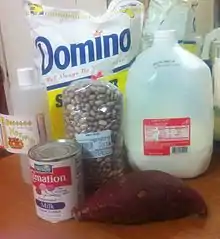Habichuelas con dulce
Habichuelas con dulce is a sweet bean liquid dessert from the Dominican Republic that is especially popular around the Easter holiday.[1] The dessert is part of the cuisine of the Dominican Republic and is traditionally garnished with milk cookies or with casabe, "a flatbread made of yuca flour."[2]
| Type | Dessert |
|---|---|
| Place of origin | Dominican Republic |
| Region or state | Latin America, Caribbean |
| Main ingredients | Red beans, cinnamon, nutmeg, coconut milk, evaporated milk, raisin, sugar, pinch of salt and vanilla |
Habichuelas con dulce is made with red beans, cinnamon, nutmeg, coconut milk, evaporated milk, raisins, sugar and salt.[2] The beans are boiled with cinnamon sticks and sweet cloves and then blended to the consistency of soup. The coconut milk and evaporated milk are added along with cooked sweet potato chunks.[3] Cloves and ginger can also be added as flavorings.
History
The origins of the dish are unclear, some historians argue that Habichuela con dulce was derived from a Turkish dish called Aşure or Ashure, also known as “Noah’s Pudding.” If this is the case, Ashure travelled to the Dominican Republic in the late 19th or early 20th century along with other classic dishes like Taboulleh and Kibbeh brought over by immigrants from the former Ottoman Empire and adapted along the way. Not only is Ashure made with similar ingredients including sugar, beans and spices, like Habichuela con dulce it is also associated with a religious period of fasting.
“The first month of the Islamic calendar is Muharrem. It is a good deed to fast the first 10 days of Muharrem, and then on the 10th day, the Day of Ashure, to cook and share ashure with your neighbors and relatives.”
Another theory argues that Habichuela con dulce is derived from a French dish that was brought over in the 19th century by colonists who had settled in what is now Haiti before moving to the Dominican Republic via Aunt Clara’s hometown, Montecristi.
How it's made

Everything is made in a pot. The thick, creamy appearance comes from a sweet potato. Red beans are used to make Habichuela con Dulce. The beans need to be soft, so they are soaked in water overnight. After the beans are soft, evaporated milk, condensed milk, and coconut milk need to be added to the mix of the beans. Before adding the milk, the mixture is dark, but after adding the milk, it lightens up while boiling. Sweet potatoes and sugar are added for the rich and creamy taste of the dessert. While adding the sugar and sweet potatoes, the mixture can be left thick, or thin so that the mixture flows better, but if it is left in the refrigerator, it will thicken as it cools.[4] Habichuela con Dulce can have added spices for a sweeter taste. While the Habichuela con Dulce is mixing, spices such as ginger, cinnamon, cloves, nutmeg and vanilla can be added depending on the family's recipe. After the mixture is done, raisins and butter are added to the mixture. Usually, the habichuela con dulce is left to cool down for a few hours before it is eaten. The dessert can also contain cookies, milk or a type of cassava bread.
Uses
A similar form of Habichuela con Dulce is red bean paste, which is a dark red, sweet bean paste. It is used in Chinese, Korean, and Japanese cuisines.
Chinese
In Chinese cuisines, red bean paste is used in:
- Zongzi, which is a form of pasteles made of glutinous rice stuffed with different fillings and is wrapped in flat large leaves such as bamboo and reed.
- Jiān dui, which is a fried pastry made from glutinous flour that can be filled with red bean paste.
- Mooncakes have rich thick filling that is made with lotus seed past or red bean paste.
- Red bean cake usual made with the outer shell of beans. The mashed beans are then mixed with gelatin and cooled for several hours before serving, just as habichuela con dulce.
Korean
- Bungeoppang This is a pastry that includes red bean paste and is roasted.
- Hobbang This snack is a ball of flour filled with red bean paste.
- Baram tteok Is a rice cake made with rice and filled with red bean paste.
- Chalboribbang is small sweet pancakes that use a spread made of red bean paste.
See also
References
- Nelly Ramirez Lo más dulce de la Cuaresma Archived 2009-02-28 at the Wayback Machine; Habichuelas con dulce. Tiene mayor demanda al inicio de este período 26 Febrero 2009 Hoy Digital
- Katrina Taveras Spilling the beans on a Dominican treasure March 19th 2008 Daily News (New York)
- recipe
- What is Habichuela con Dulce